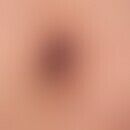Synonym(s)
DefinitionThis section has been translated automatically.
Rare skin disease that can occur in the wake of pacemaker implantations (also possible with other types of implants). The erythema can persist for years. Itching is not obligatory, but can be considerable. S.a. Implant intolerance.
EtiopathogenesisThis section has been translated automatically.
The pathogenesis of this clinical picture is controversial. In contrast to the postoperative pacemaker infections, physical causes (mechanical irritation, flow obstruction by the implanted "foreign body", pathogenic electromagnetic field) are assumed for these reactive skin changes. Furthermore, in connection with positive epicutaneous tests, type IV sensitization to silicones, epoxy resins, nickel, cobalt chloride, were detectable in individual cases, allergic reactions of the delayed type are discussed as the triggering cause.
You might also be interested in
ClinicThis section has been translated automatically.
Partly reticular, partly laminar redness which in the cases described is located above the implantation site. Histology: Discrete lymphocytic perivascular infiltrates around dilated vessels. No significant spongiosis. The image is non-specific.
Differential diagnosisThis section has been translated automatically.
A distinction must be made between the bland "pacemaker erythema" and the "post-implantation syndrome" associated with severe systemic reactions, first described by Valezquez in 199, which is characterized by postoperative fever, leukocytosis, increase in CRP and blood coagulation disorders after "endovascular repair (EVAR)" of arterial vascular defects.
Note(s)This section has been translated automatically.
To what extent the "pacemaker oedema (with telangiectasia)" differs from a "pacemaker dermatitis" caused by possible type IV sensitizations is unclear.
Case report(s)This section has been translated automatically.
A 64-year-old man suffering from a degenerative cardiomyopathy with sick sinus syndrome (SSS) was implanted with a pacemaker (only was II,) which was implanted subcutaneously at the left sectoral regions. Three years later (!) the patient noticed a considerably itchy erythema above the pacemaker implantation site. In the following period the skin condition deteriorated continuously despite external application of a corticoid ointment.
Epicutaneous testing (standard allergens): No evidence of relevant type IV sensitization.
Laboratory chemical parameters were inconspicuous. No CRP elevation, no SPA acceleration.
Histology: superficial perivascular dermatitis. Occasional detection of eosinophilic leukocytes. Non-specific findings.
Due to the pronounced symptoms, oral therapy with methylprednisolone was initiated. The therapy was subsequently reduced to 10 mg per day. 5 months later the patient was still receiving 10 mg per day) the reddening of the skin had largely disappeared. The attempt to "sneak out" failed. After explantation of the defibrillator the skin changes healed completely.
LiteratureThis section has been translated automatically.
- Kopera D et al.(1994) Pacemaker erythema with telangiectasia. dermatologist 44: 716-718
- KreftB et al (2014) Erythema and swelling after implantation of a cardioverter defibrillator (ICD). Allergo J 23: 66
- Lin YC et al (2003) Telangiectatic pacemaker erythema. Clin Exp Dermatol 28:447-448
Voûte MT et al. (2012) Stent graft composition plays a material role in thepostimplantation
syndrome. J Vasc Surg 56:1503-1509.- Wimmershoff MB et al. (1998) The artificial pacemaker erythema. German Med Weekly 123:441
Outgoing links (1)
Implant incompatibility (overview);Disclaimer
Please ask your physician for a reliable diagnosis. This website is only meant as a reference.




